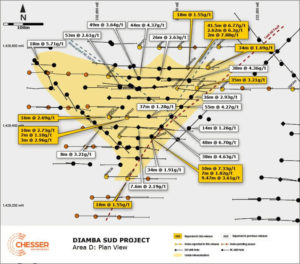Chesser keeps the thick, high-grade gold hits coming in Senegal
Mining
Mining
Chesser continues to intersect thick, high-grade oxide gold mineralisation at its Diamba Sud project in Senegal along with further deeper, high-grade hits.
Results such as 41.5m grading 6.77 grams per tonne (g/t) gold from 17m and 10m at 7.33g/t gold from 16m have confirmed the thick, high-grade nature of the oxide mineralisation at Area D of the project.
And that’s a good thing as oxide mineralisation is often free milling – allowing a significant portion of the precious metal to be recovered by simple, low cost concentrating methods.
“The diamond holes not only confirmed the thickness and grade of oxide mineralisation but importantly the deeper high-grade intercepts will aid our understanding and targeting of the deeper feeder mineralisation below the high-grade oxide mineralisation in Area D,” Chesser Resources’ (ASX:CHZ) chief executive officer Andrew Grove noted.
“Drilling is currently progressing on some of our high priority southern exploration targets. We look forward to reporting these results as they are received.”
Further results are expected to be received from drilling at Area D as well as its other high priority exploration targets at Western Splay and Southern Arc.

Most of the four diamond holes and 16 reverse circulation holes were drilled in Area D save four RC holes that were from Area A.
The Area D drilling was designed to determine the extent of the high-grade, flat-lying oxide zone and the underlying fresh rock sulphide mineralisation.
Mineralisation in both the oxide and the underlying fresh rock appears to trend in a northwest and northeast direction controlled by faulting.
In the northwest, the oxide mineralisation appears to be locally conformable with the interpreted northeast-southwest trending fault that offsets Area A and Area D.
It also remains open in that direction although more confined to the southwest.
Meanwhile, in the central area mineralisation appears to have extended to the west with outstanding assay results expected to determine how far the mineralisation extends to the west and northwest in that area.
In the southern area, mineralisation appears to be confined around the trace of the interpreted northeast-southwest trending fault while remaining open to the southwest.
Drilling to date has also outlined a broad zone of mineralised breccias and stockworks in the fresh rock below the high-grade oxide mineralisation.
Chesser says the current interpretation is that this zone is stratiform and possibly stratabound within a favourable host carbonate dominated lithology, which dips variably to the northwest and strikes approximately northeast.
Over at Area A, the RC holes in the southern-most line of drilling returned narrow mineralised intercepts which indicate that the northeast structures appear to be still trending through the area.
These structures continue to represent priority exploration targets as there is potential for wider and higher-grade mineralisation to exist along strike, as indicated by the high-grade mineralisation developed to the northeast.
With drilling completed over both Area A and D, the rigs are currently drilling high-priority exploration targets at Western Splay and Southern Arc.
The company is also carrying out a full geological review of all the data with geological modelling being conducted to prioritise new targets.
The next drill program will aim to infill and extend the identified mineralisation, demonstrate the scale of the mineralised systems, and to better understand the controls on mineralisation.
This is expected to provide enough data for Chesser to start initial resource estimation studies over both Area A and D.
This article was developed in collaboration with Chesser Resources, a Stockhead advertiser at the time of publishing.
This article does not constitute financial product advice. You should consider obtaining independent advice before making any financial decisions.